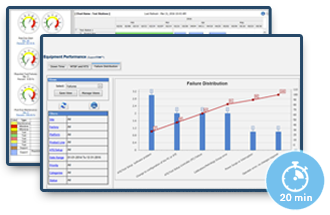

Covid-19 has accelerated transformation efforts across many industries. With the use of tools like Zoom and MS Teams making it possible to work effectively and satisfactorily from home, many enterprises are electing to redesign and consolidate their facilities. It is ironic that these moves, made possible by technology, may initially be thwarted by technology, particularly in asset-intensive environments. Old and obsolete asset management technology, practices, and mindsets will make this transition slower, more costly, and more frustrating than it needs to be. More capable Enterprise Asset Management practices not only will help ensure a smoother transition but can also be used to optimize the inventory of test equipment to better support the mission of the business.
Hybrid Working Arrangements in Asset-Intensive Operations
Zoom won’t be the miracle solution here. Today’s asset management capabilities assume everyone will be at work together and be able to “put eyes on” any assets they need more information about…if they assume anything at all. They could easily walk to a lab and have any question answered about an asset as they prepared project plans that include their use. After these facility transformations take place not everyone will be working in the office but people working from home will still require knowledge at their fingertips about the array of assets their teams will be using. Complicating matters, there will be places where assets and infrastructure are moving but some cross-functional team members are not, like project managers, some engineers, as well as functional managers, and others. These teams still must be able to coordinate impeccably to move at the speed required to win as we write about in, “Win the Race with Better Coordination of Capacity and Constraints.”
Enterprise Asset Management is in the Midst of its own Transformation
Most of today’s enterprise asset management systems and solutions were designed for the previous industrial revolution and reinforced the mindsets and intentions of that time. Asset management typically exists in its own department with its own standardized practices. In this way they were no different than any other department, each isolated with their own tools and processes, optimizing locally without concern for other departments. We write about hoarding quite a bit in our blog. It is what people do to optimize locally, and it is made necessary by weak asset management practices. These practices were once competitive but today they result in costs in operations that are no longer competitive.
-
Asset Utilization of 10% to 30% versus double to quadruple
-
Overspending on equipment and support of 25% to 75%
-
Delays due to asset availability of 10% to 30%
How Must Enterprise Asset Management Help Facility Transformation?
Plans to move assets as part of a facility transformation and consolidation are only as good as the accuracy and completeness of the knowledge you have about the assets and their use. Speed is critical, which is not possible without the knowledge to forecast the use of assets and means, at times, where to move an asset is at best a “shot in the dark” and at worst is a ticking time bomb waiting to explode. Missing, flawed, and incomplete information about asset locations, configurations, capabilities, uses and users, size, obsolescence, health, and maintenance requirements leads to flawed plans and operational breakdowns that emerge immediately or “explode” sometime later. To be competitive teams must avoid avoidable costs that delay schedules.
Costs that Inevitably Result from Poor Asset Data
-
Reduced revenue throughput or delayed project or time-to-market caused by
-
Lost assets mean delays to getting facilities operational
-
Asset downtime caused by gaps in knowledge about asset health, maintenance, or support schedules
-
Lack of asset capability knowledge leading to delays and “do-overs”
-
-
Increased Costs
-
Searching for / tracking assets, incurring additional shipping cost
-
Replacing assets
-
Repairing assets
-
Small, Inexpensive Assets Can be the Most Costly
Why? Because we often don’t think they are as important. It is a truth in our experience that there is no correlation between the size or cost of an asset and its ability to cause delays in operations. Asset managers often put their attention on the large and expensive assets on their balance sheet and have limited or no knowledge of the other ancillary tools required to make those assets useful. These assets are often tracked by individuals on spreadsheets, if at all, that get lost in moves or when people retire.
When you consider the opportunity cost incurred when…
-
projects or products are delayed
-
revenue targets are missed, or
-
your key technical talent is distracted from producing value
…it becomes clear managing these assets and having more detailed information about them is critical.
Key Enterprise Asset Management Capabilities Required for Speedy Transitions
These are the same capabilities that enable teams to operate with speed and resilience to quickly respond to changing situations. These transformations amount to nothing for than a changing situation with its set of threats and obligations that our practices help with.
Contextual Knowledge – Embedded in workflows to quickly be able to determine the configuration, capability, location, and use of any asset or set of assets you own or are renting.
Cross-Functional Integration – enabling all members of a cross-functional team to be associated with the assets required for their project or operation, the functional obligations each has to the assets (maintain it, schedule it, use it, ensure conformance of it, fix it, etc.)
Configuration and Use Maps – Maps that associate projects, cross-functional staff, and assets that are required to anticipate resource constraints and plan contingencies quickly. These capabilities are made possible by the embedded knowledge and functional integration previously mentioned.
-
Historical Configuration and Use Map – Using fact-based historical data gathered through operations to map what is really required or not.
-
Planned Configuration and Use Map – Mapping the planned move against what is known from the historical map to anticipate risks and plan contingencies.
-
Implementation Priorities – tied to schedules for product test constantly being updated by project managers
Request a Demo

See how Scireo aEAM Software drops asset and support costs by 50% while accelerating time-to-market 2X.
Relevant Content
Asset Management Best Practices: Navigating Covid-19
We’ve relied very much over the years on informal “water cooler” or “hallway” conversations to get caught up, coordinate, and build background narratives with our colleagues and teams at work; To check progress and see where people need help. These have been habitual practices that make things work but are now severely curtailed. These conversations…
The Pandemic Has Exposed Asset Management Failings & Opportunities
The Covid-19 pandemic has been a huge disruption, but if we are honest it has already shown us how unprepared we are to react to quickly changing events effectively. This capability to adapt is a competitive necessity today with or without the pandemic. To compete in the 4th Industrial Revolution requires resilience and speed and…
Covid-19 and The Urgency for Change. Finding & Navigating Dangerous Bumps!
Businesses have been grappling for years with changes in technology and practices driven by the new competitive requirements of the 4th Industrial Revolution (IR4). Then the Covid-19 pandemic appeared and that urgency drove new practices because they were required immediately to continue operations. The pandemic has kicked off a race for improvements and digitization that…
Soar With New Competitive Asset Management Capabilities! If You Want to Accelerate, Take Your Foot off the Brakes.
The competitive landscape is changing fast. It is an exciting and dangerous time. New competitive requirements for speed and efficiency – doubling speed and reducing costs in half – cannot be achieved with historical approaches focused only on myopic views of asset performance, e.g. asset downtime, MTBF, OEE. While still important, rather than ends in…
Notable Quotes
“Sente’s Scireo® solution sets a new benchmark in customer experience by increasing collaboration and communications among all participants of a test program. They drive cycle time and cost efficiencies, optimizing asset utilization and technical labor productivity, and applying best practices in knowledge management to increase speed and drive standardization of test resources.”
Frost & Sullivan Analyst









